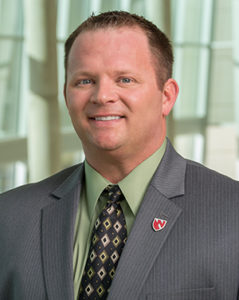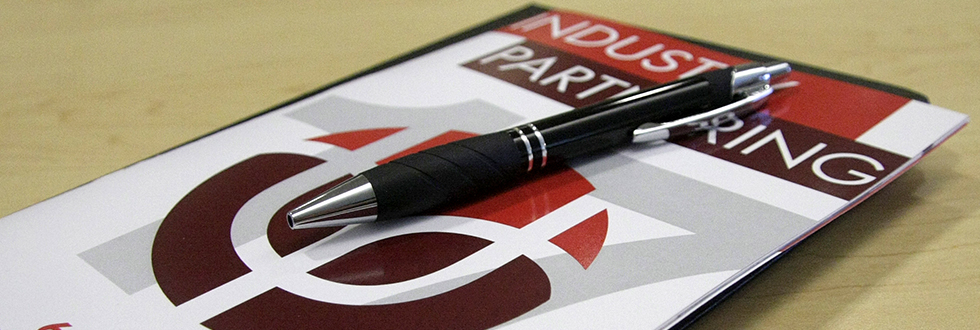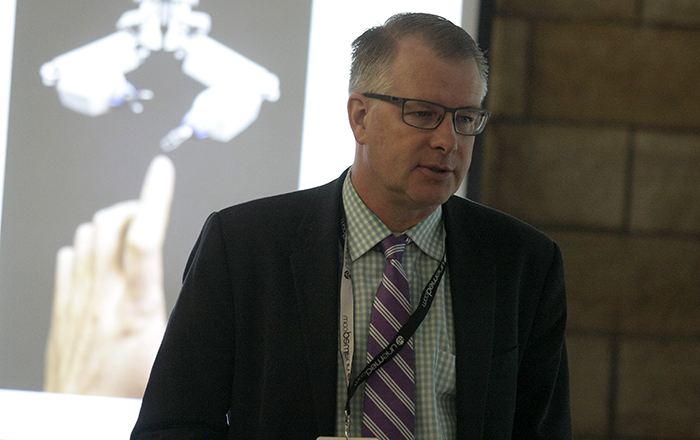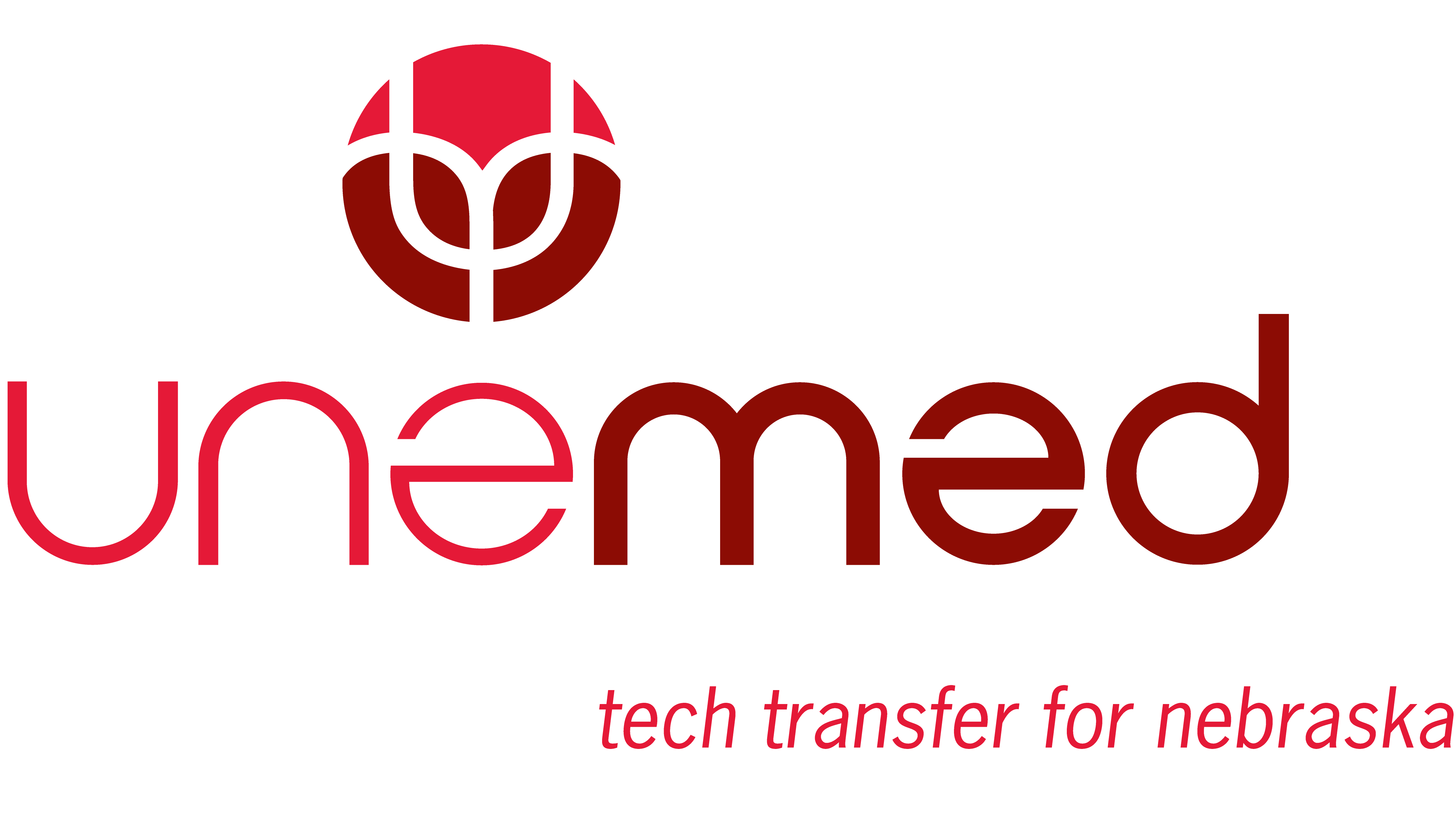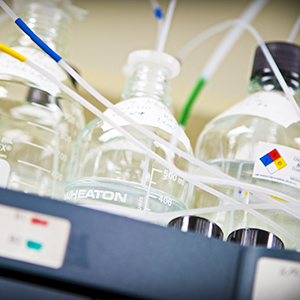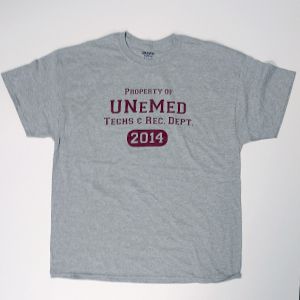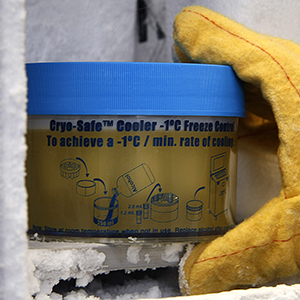UNMC’s nanoparticle production facility to headline seminar series
OMAHA, Neb. (July 19, 2017)—An upcoming Tech Talk Seminar Series installment will detail the manufacturing capabilities of UNMC’s Nebraska Nanomedicine Production Plant.
Adam Szlachetka, D.D.S., Operations Manager at UNMC’s nanomedicine production facility, will deliver an hour-long talk beginning at 1 p.m. on Tuesday, Aug. 8, in room 1004 of the Durham Research Center I.
The seminar is titled as “Good Laboratory and Current Good Manufacturing Practices (GLP and cGMP) at UNMC within the Nebraska Nanomedicine Production Plant (NNPP).”
Dr. Szlachetka is expected to discuss the NNPP’s capabilities of biomedical manufacturing, including its ability to scale up from a relatively simple idea to an FDA-approved final product. The NNPP is particularly useful for those interested in manufacturing on a small scale while maintaining the high standards found in large-scale manufacturing firms.
A bimonthly event, the Tech Talk Seminar Series highlights “the variety of ways core technologies can be applied to research questions,” according to the seminar website. The Office of Vice Chancellor for Research is the series sponsor.
Find more information about the series, including links to videos of previous seminars, at https://www.unmc.edu/vcr/education/seminars/tech-talks/index.html. All seminars are live-streamed and available for later viewing. Admission is free and open to all.
FDA grants orphan drug status for UNMC therapy
Designation will help Juvenile Batten Disease therapy move into clinical trials before end the year, officials say
NEW YORK and CLEVELAND (July 5, 2017)—The FDA announced recently that it has granted Abeona Therapeutics Inc. the Orphan Drug Designation for its work on a gene-therapy approach to Juvenile Batten Disease, according to an Abeona press release issued last week.
“This designation helps advance the [Juvenile Batten Disease gene therapy] program and we look forward to initiating human clinical trials later this year,” Abeona President and CEO, Timothy J. Miller, PhD, said in the release.
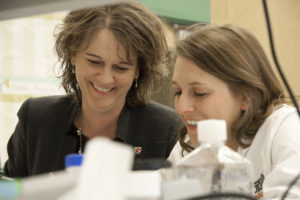
UNMC Professor of Pathology Tammy Kielian, PhD, (left)—seen here with doctoral student Megan Bosch—is UNeMed’s 2015 Innovator of the Year for work against Juvenile Batten Disease and biofilm infections.
Abeona is a biopharmaceutical company focused on gene therapy approaches for rare deadly diseases. Abeona’s work with Juvenile Batten Disease is based on the research of Tammy Kielian, PhD, one of the University of Nebraska Medical Center’s most celebrated and talented researchers.
Dr. Kielian was the 2016 Scientist Laureate, UNMC’s highest honor bestowed on researchers, and was named the 2015 Innovator of the Year by UNMC’s technology transfer and commercialization office, UNeMed.
Dr. Kielian directed her research toward Juvenile Batten Disease several years ago when her young niece was diagnosed with the fatal neurodegenerative disorder.
According to Abeona’s press release, the “Orphan drug designation is granted by the FDA to novel drugs or biologics that treat rare diseases or conditions affecting fewer than 200,000 patients in the U.S. The designation allows the drug developer to be eligible for a seven-year period of U.S. marketing exclusivity upon approval of the drug, as well as tax credits for clinical research costs, the ability to apply for annual grant funding, clinical trial design assistance, and the waiver of Prescription Drug User Fee Act (PDUFA) filing fees.”
Dr. Kielian was also named a UNMC Distinguished Scientist in 2009 and won UNeMed’s Emerging Inventor Award in 2012.
UNeMed hosts partnering day for medical devices
OMAHA, Neb. (June 14, 2017)—The Industry Partnering Summit entered its second year Wednesday when UNeMed hosted a small gathering of entrepreneurs, venture capitalists, medical device professionals and University inventors.
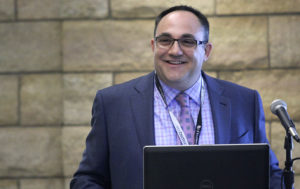
Inventor/Founder Greg Gordon, M.D., presents his startup company, Radux Devices, during UNeMed’s 2017 Industry Partnering Summit.
UNeMed, the technology transfer and commercialization office for the University of Nebraska Medical Center, selected a core group of university medical device innovations and presented those inventions to industrial officials, investors and potential partners.
“I think it went well,” said Matt Boehm, UNeMed’s licensing manager who coordinated the event. “We did exactly what we wanted to do, which was get all these people in the same room and have some meaningful conversations.”
The all-day event was led by inventor-founder Greg Gordon, M.D., of Radux Devices. While at UNMC, Dr. Gordon invented several devices to protect physicians from radiation while improving outcomes of fluoroscopic procedures.
He was followed by Peter Pellegrino, a doctoral student working with Irving Zucker, PhD, who’s developed a way to make a new hypertension treatment possible. The new treatment involves destroying misfiring nerve-endings in the kidneys, and Zucker’s device would make that process far more effective.
Several other surgical devices were presented, including a new surgical robot, a cutting tool, an implant and new laparoscopic devices.
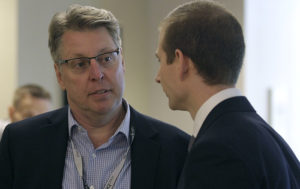
Medtronic’s Doug Hettrick (left) meets with UNMC’s Peter Pellegrino during UNeMed’s 2017 Industry Partnering Summit.
Shane Farritor, PhD, an engineer based at the University of Nebraska-Lincoln, showed off the surgical robots that drive his startup company, Virtual Incision. He is a co-founder with UNMC surgeon Dmitry Oleynikov, M.D.
Jason MacTaggart, M.D., a vascular surgeon at UNMC, presented his prototype for AquaBlade, a small waterjet designed to better treat aortic dissections from inside the vessel.
Marius Florescu, M.D., developed an implantation device that will help a vein and artery better form what’s known as an arteriovenous fistula—a critically important first step for patients with kidney failure to receive hemodialysis.
Jake Riggle, M.D., presented the latest prototype of his Intuitool, an ergonomically engineered laparoscopic tool.
The last of the surgical tools was a portable laparoscopic platform from Chandrakanth Are, M.D. The device would make minimally invasive surgeries more accessible throughout the world.
Other presentations were:
Alexey Kamenskiy, PhD, presented an innovative solution to stopping massive bleeding during catastrophic injuries.
Thang Nguyen’s wound irrigation system delivers constant and consistent pressure to wash thoroughly small foreign objects from wounds.
A device out of Jennifer Yentes’ lab at the Biomechanics facility at the University of Nebraska at Omaha rounded out the remaining presentations. Yentes, PhD, developed a wearable technology that might help doctors predict when a patient with chronic obstructive pulmonary disease is about to suffer a sudden and potentially fatal increase in symptoms.
Learn more about the presented technologies by viewing or downloading the event program below.
University of Nebraska among the nation’s best in tech transfer
LINCOLN, Nebr. (May 12, 2017)—A new report measuring universities’ success in driving economic growth ranks the University of Nebraska among the nation’s elite.
The Milken Institute, an independent economic think tank, last month released “The Best Universities for Technology Transfer.” The report ranks Nebraska’s tech transfer efforts 35th among a field of 225 – putting NU in the top 16 percent nationally for its ability to commercialize the work of its faculty in areas like agriculture, engineering and medicine for the benefit of people in the state and around the world.
“This report is more evidence that the University of Nebraska is in great company when it comes to our research and economic development efforts,” said NU President Hank Bounds. “We’ve made it a priority across all of our campuses to create a culture of innovation where bold and entrepreneurial thinking is encouraged. Our work is paying off. This ranking is a credit to the dedication and creativity of our faculty and the technology transfer offices that support them. Nebraska’s economy and our citizens are the beneficiaries.”
The Milken Institute’s rankings are based on data from the Association of University Technology Managers, the national trade organization for university tech transfer offices. Metrics include patents issued, licenses issued, licensing income and startups formed.
Nebraska’s No. 35 ranking places it ahead of brand-name heavyweights like the Mayo Foundation (No. 36), Wisconsin (No. 40), North Carolina-Chapel Hill (No. 44), Ohio State (No. 55) and Princeton (No. 62). NU trailed Johns Hopkins by just two places.
NU’s technology transfer offices – UNeMed at the University of Nebraska Medical Center in Omaha and NUtech Ventures at the University of Nebraska-Lincoln – work to bring university research to the marketplace, resulting in new startup companies, better jobs and new and innovative products that improve productivity and quality of life. The university is working to deepen relationships with Nebraska companies that can license faculty inventions for commercial use, the way Omaha-based Streck has done for a new molecular diagnostic platform.
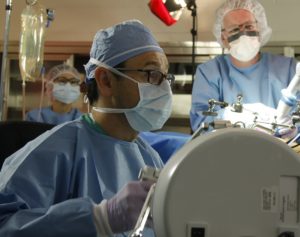
UNMC surgeon Dmitry Oleynikov (left) and UNL engineer Shane Farritor test a surgical robot prototype during a recent trial in Omaha. Their collaboration created a startup company, Virtual Incision, which hopes to make major surgery—like a bowel resection—a laparoscopic procedure.
For example, Virtual Incision Corp., a medical device company focused on developing a miniature robot for general surgery abdominal procedures, is a spinoff of research by Nebraska-Lincoln engineering professor Shane Farritor and UNMC surgeon Dmitry Oleynikov. Technology developed at Virtual Incision will transform surgeries into more affordable, less invasive procedures, improving lives and surgical outcomes for patients around the world.
Epicrop Technologies Inc., a startup founded by Nebraska-Lincoln faculty, is located at Nebraska Innovation Campus and is developing technology to improve crop yields. Epicrop’s unique technology, which the company is commercializing for use in corn, soybeans and wheat, can improve yields and stress tolerance without changing the DNA sequence of the plant.
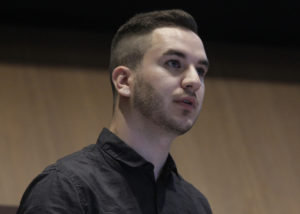
Avert CEO Preston Badeer, during UNeMed’s 2016 UNMC Technology Demonstration Day in October.
Another company, Avert, is a startup spun from innovation at the Nebraska Biomechanics Core Facility at the University of Nebraska at Omaha. Avert, which was recently among a select group of startups chosen to present at a national demonstration day, is about to launch a beta version of its concussion-detection device. Avert is developing its product in partnership with UNeTecH, a joint UNO-UNMC business incubator formed by the Board of Regents that brings biomedical technology innovations to market.
“It is exciting to see medicine and technology work together to break down silos and build bridges,” said UNMC Chancellor Jeffrey P. Gold, M.D. “The real finish line is when academic research changes a person’s life – takes their pain away, helps them walk more easily, speeds recovery time after an operation. Partnering with businesses and corporate communities can help us take our innovations and discoveries to the people who need them most, and I’m pleased to see by this ranking that we are accomplishing our goals.”
Nebraska-Lincoln Chancellor Ronnie Green said, “Nebraska innovation is changing lives. We are leaders in invention and enterprise, driven by the high-quality, relevant research from our faculty. Our research is tied directly to real-world impacts – job creation, partnerships and business start-ups that power our state’s economy.”
According to the Milken report, university commercialization efforts pumped more than 1,000 new startup companies and $2.5 billion into the national economy. The report concludes: “Research universities are one of the strongest assets America can use to compete in the age of innovation. Research funding should be a top priority for enhancing American economic growth.” Its recommendations include:
- Maintaining federal funding for basic science research.
- Creating a federal fund to further support academic commercialization efforts.
- Setting up a federal matching grant program to increase technology transfer staff and resources.
- Creating a standard of best technology transfer practices at the state level.
The University of Utah claimed the top spot in Milken’s rankings, followed by Columbia University, the University of Florida, Brigham Young University and Stanford University.
CRISPR and the other half
by Joe Runge, UNeMed | May 10, 2017
CRISPR is not the technology that will bring about bioengineered weapons of mass destruction, the cure to all diseases or a generation of superhuman children. CRISPR is not the technological endgame for genetic engineering that will save or, possibly, destroy the world.
CRISPR is half that technology.
CRISPR is an enzyme that quickly, precisely and cheaply targets and cuts DNA. Originally discovered in bacteria, CRISPR is short for clustered regularly interspaced short palindromic repeats. It’s a DNA-eating enzyme that serves as a form of immunity for bacteria. Bacteria save a chunk of an invading virus’s DNA and stick it to a CRISPR enzyme. The DNA-loaded enzyme then cruises the bacteria, looking for that same viral DNA. When the enzyme finds the viral DNA, it cuts it up, destroying the virus.
The early applications of CRISPR solve problems caused by small mutations that make genes dysfunctional. The CRIPSR simply cuts out the mutation, which makes the gene function normally. Cutting, however, is only half of the solution. To create flying pigs or genetically modify embryos for designer babies, scientists would need to insert new DNA.
But inserting new DNA is inefficient. Cells, quite reasonably, are on the prowl for foreign DNA, and work hard to keep it out. In the lab, a scientist would need to CRISPR hundreds of cells for a reasonable chance of successfully inserting DNA into just one – and that’s just for a small insertion, a fraction of a gene. To insert or replace a functioning gene, those odds go from pretty long to functionally impossible. Only through a series of baffling experiments can a scientist hope to insert functioning genes into a living cell.
An international collaboration between the University of Nebraska Medical Center and Tokai University may have found CRISPR’s other half.
Channabasavaiah Gurumurthy, PhD, an assistant professor of developmental neuroscience at UNMC, and Masato Ohtsuka, PhD, an associate professor of molecular life science at Tokai University in Japan, invented a new approach to efficiently insert DNA molecules as large as some genes.
Drs. Gurumurthy’s and Ohtsuka’s invention, which they call Easi-CRISPR, promises to be the improved inserter that pairs with CRISPR’s elegant cutting ability. In mice, Easi-CRISPR inserted large segments of DNA with unheard-of efficiencies of 25 percent, 30 percent or even 100 percent. Easi-CRISPR makes it possible to insert entire functioning genes into the cuts made by CRISPR.
Just as efficient cutting expanded the applications of genetic engineering, efficient insertion further transforms what scientists can do. Instead of using CRISPR to trim out the small mutations, they can overwrite entire genes. Instead of deactivating troublesome genes, they can remove or even add foreign genes to organisms. Genetic engineering applications were once the expensive work of specialty laboratories. With CRISPR and Easi-CRISPR, precision cutting and insertion can become a routine part of molecular biology.
Of course, easy cutting and inserting are not enough to fully realize designer babies and biologic super weapons. Easi-CRISPR and CRISPR make genome editing easier but it’s not enough on its own. A designer baby studio would need a library of eye color, athletic talent and academic achievement genes ready for insertion. To cure a disease, scientists will need to learn how to better use CRISPR to target, edit and replace living human cells. Easi-CRISPR is proof that very brilliant people are working tirelessly to overcome these current and future limitations of genome editing.
Now is the time to inspire the next generation of women in STEM
by Catherine Murari-Kanti, UNeMed | May 3, 2017
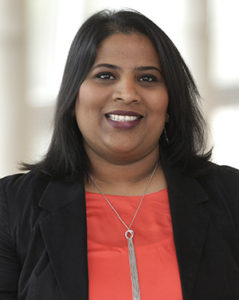
Dr. Murari-Kanti
This past weekend I witnessed something exciting. I got a glimpse into the future. A future that has strong, young confident ladies leading the way. This was possible because I was invited to be a panelist at a STEM conference for seventh and eighth grade girls. STEM is an education initiative emphasizing fields related to science, technology, engineering and mathematics.
The University of Nebraska Medical Center, in collaboration with Bellevue University, put together a daylong seminar: “Expanding your horizons in math and science – a conference for young women.” There, about 150 middle school girls from the Omaha and Bellevue public school districts got together to discover different STEM careers and get advice and encouragement for women holding STEM careers.
The day began with breakfast, followed by a great talk by the keynote speaker Katie Barton, Executive Director of Software Development and Services at Gallup, Inc. Her energetic personality and humor elicited peals of laughter and giggles. She stated facts about how women were underrepresented in almost all STEM careers. She said 50 percent of girls in middle school want to participate in STEM education. But only 20 percent actually pursue a STEM education and career after high school.
The girls participated in the Clifton StrengthsFinder survey, an assessment tool that helps identify their specific talents and discover what they naturally do best. She encouraged the girls to understand their strengths and recognize their weakness’ that would make their career planning easier. As Barton provided career solutions based on each strength, the energy in the auditorium was palpable. It was the quiet recognition that girls can achieve anything they want in life and be successful, despite societal challenges and existing disparities.
Barton shared three critical areas where women give up on careers in STEM. First are the women who struggle to get their first break in a STEM job. The second is when they choose between a family and a successful career. Third is when they are passed over for promotions to their male counterparts.
The Gallup executive said it was up to the girls to stand up and make a mark for themselves; to work hard; have good work ethic; develop good relationships with their superiors; and push for what they wanted to achieve. Barton was a tough act to follow, but I was up next to share my educational background and career story.
They laughed when I told them I was in school continuously for 30 years, preschool to graduate school. I told them about my role as a Licensing Associate at UNeMed. I explained how innovation, technology transfer and intellectual property affects them. I told them how innovation usually starts with an idea or a solution to a problem. I encouraged them observe their surroundings and find solutions to problems. They asked me questions about my background, the work I do and what excites me to come to work every day.
I shared stories about entrepreneurs who came up with simple solutions to life’s difficulties and they listened to me with rapt attention. Many girls expressed a desire to pursue biology and chemistry, while there was one who was absolutely in love with math, and wanted to eventually get a doctorate in mathematics. I was excited to see the glimmer of excitement for the future in these girls’ eyes.
I was fortunate to share the room with other spectacular woman panelists successful in various fields such as database management at Mutual of Omaha, environment safety and hazardous material management from the U.S. Army Corps of Engineers, cytogeneticist and post-doctoral researchers from the University of Nebraska Medical Center, clinical psychologist from Boystown Hospital, research and development project manager from Teledyne Cetac Industries, Six Sigma Black Belt, enterprise quality and outcome coordinator at Nebraska Medicine, financial advisor at UBS, nurse at Alegent Health and IT representatives from Gallup.
I am excited for the future of STEM education and careers for girls in Nebraska. As a woman in STEM, I believe I have the ability to influence, educate and empower girls to choose an education and career in scientific fields. The girls I met are smart, bright, outgoing and funny. They have a desire to make it big, and I think the responsibility lies on all of us to push them to achieve their goals.
I am thankful for the opportunity to represent UNeMed at this event, and empower the next generation of women for a brighter future.
UNMC group takes second place in business plan competition
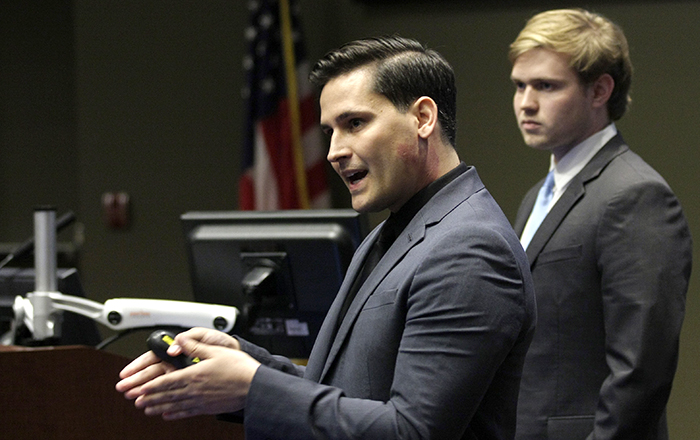
UNMC graduate students Tim Bielecki (left) and Will Payne address judges’ questions during UNO’s business plan competition Thursday, April 27, 2017.
OMAHA, Nebraska (April 28, 2017)—A group from the University of Nebraska Medical Center finished in second place of the University of Nebraska at Omaha’s seventh annual Maverick Business Plan competition last night at Mammel Hall.
The group, primarily made up of current and former graduate students at UNMC, took home the runner-up prize of $2,000.
“It will definitely help having that money,” said Will Payne, a UNMC doctoral candidate and co-founder of Orca Analytics. “We’re going to take that money and do exactly what we need.”
Most of the cash will be used for various legal fees as Orca Analytics prepares for a product launch, Payne said.
Orca Analytics is a venture that plans to use data and predictive analytics to guide collegiate advisers and their students to the most efficient career path. Founders expect their tool will enhance student satisfaction and engagement while boosting college retention rates.
“As a student,” Payne said after, “I wish this was something that was available to us.”
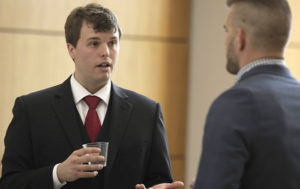
Orca Analytics co-founder Tyler Scherr, PhD, meets with guests shortly before final presentations at UNO’s business plan competition Thursday, April 27, 2017.
Orca Analytics was one of just six finalists that presented during the final round of competition, and was the first UNMC team to place.
“This is the best group of finalists we’ve had in seven years,” said Dale Eesley, the event coordinator and Director of UNO’s Center for Innovation, Entrepreneurship and Franchising, which hosted the event. “This one was really close. They were all so good, so well-thought out and so well-presented.”
The top prize of $3,000 went to a UNO-based team of entrepreneurs who founded an online clothing boutique, Mauve. Third place, and $1,000, went to a business plan that proposed a hydroelectric power facility in Nepal. The same proposal was also awarded an additional prize for the best plan that “incorporates sustainability.”
“I was actually encouraged to see this kind of quality and talent in Omaha,” said Tim Bielecki, an Orca co-founder and UNMC doctoral candidate.
Remaining members of the Orca team are Tyler Scherr, PhD, a recent UNMC graduate and Ben Jones, co-founder of the graphic design firm, Lab Rat Design.
The three remaining business plan finalists were ANCHA, a proposal for legally reselling pre-owned software; Equiband, a wearable device that helps users track their mental states; and Traveling Teachers, a service that connects qualified teachers to families who want to home-school their children but can’t for a lack of time or proper training.
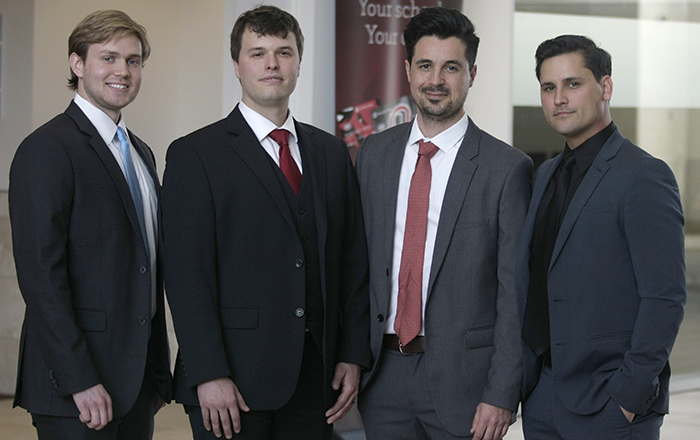
Founders of Orca Analytics are (from left) Will Payne, Tyler Scherr, Ben Jones and Tim Bielecki.
Murari-Kanti accepts full-time position
 OMAHA, Neb. (April 27, 2017)—Catherine Murari-Kanti, PhD, has been promoted from intern to a full-time licensing associate position with UNeMed, the technology transfer and commercialization office at the University of Nebraska Medical Center.
OMAHA, Neb. (April 27, 2017)—Catherine Murari-Kanti, PhD, has been promoted from intern to a full-time licensing associate position with UNeMed, the technology transfer and commercialization office at the University of Nebraska Medical Center.
“Dr. Murari-Kanti is one of those rare people who had a clear trajectory right from the beginning,” UNeMed president and CEO Michael Dixon said. “She’s been on our radar basically since she first arrived on campus about five years ago. It’s great to have someone like her who can hit the ground running like she has.”
The promotion and full-time status expands her role of evaluating, marketing, and seeking partnerships for new inventions, cures, treatments and medical devices developed at UNMC.
UNeMed’s mission is to help UNMC researchers, faculty and staff move innovations and ground-breaking discoveries beyond the laboratory and into the marketplace. Dr. Murari-Kanti joins UNeMed’s talented stable of licensing experts who work every day to advance UNMC’s new discoveries into the future cures and treatments that might one-day affect millions around the world.
“I’m excited as a graduate of UNMC to have the ability to share exciting discoveries made here, with the world,” Dr. Murari-Kanti said. “I’m proud that my career started with UNeMed and look forward to learn and grow in technology transfer and better serve the UNMC and Omaha community.”
A native of Mumbai, India, Dr. Murari is the daughter of Krishnamurty and Vijayakumari Murari. She is a 2009 graduate of Creighton University in Pharmaceutical Sciences with an undergraduate degree in Pharmaceutical Sciences from the University of Mumbai. Dr. Murari-Kanti received her doctorate in Cancer Research from UNMC in 2015.
UNMC group makes cut in UNO’s business plan competition
OMAHA, Nebraska (April 26, 2017)—A group from the University of Nebraska Medical Center is believed to be the first to advance to the final round of the University of Nebraska at Omaha’s seventh annual Maverick Business Plan competition tomorrow.
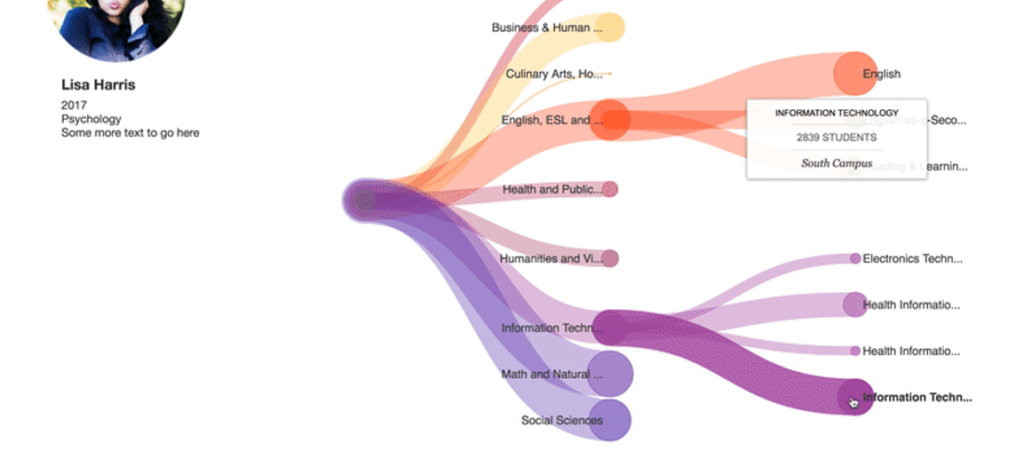
A screenshot of Orca Analytics’ interface that diagrams a theoretical student’s pathways to potential career options.
The group, primarily made up of current and former graduate students at UNMC, will pitch their plan for “Orca Analytics.” It’s a venture that uses data and predictive analytics to help guide collegiate advisers and their students to make the most of the educational experience. The cloud-based software application illuminates the most efficient path of courses for a student, presumably leading to better career options upon graduation. The same applications would also help advisers maintain a better sense of their students’ progression.
Members of the Orca team are Tim Bielecki and Will Payne, doctoral candidates at UNMC; Tyler Scherr, PhD, a recent UNMC graduate; and Ben Jones, co-founder of the graphic design firm, Labrat Design.
UNO’s business plan competition is sponsored by the College of Business Administration’s Center for Innovation, Entrepreneurship and Franchising. Final presentations, five minutes each, are scheduled for Thursday, April 27, 2017, beginning at 6-7:15 p.m. at Mammel Hall. Guests can meet and greet all finalists during a meet and greet session at 5:15 p.m. The event is free and open to the public.
A panel of judges will weigh the proposals for market opportunity, practicality and impact to determine the winners. Cash awards will be presented to the top three finishers, with $3,000 going to the first place, $2,000 to second place, and $1,000 to the third place finishers.
An additional prize will be awarded to the plan that best “incorporates sustainability,” and audience members will have a chance to win $300 in door prizes.
My first AUTM
Tech transfer newbie relates her first experience at AUTM’s annual conference
by Catherine Murari-Kanti, UNeMed | April 19, 2017
My last experience at a conference involved standing in front of a scientific poster for hours, and listening to scientific talks that almost always went over the allotted time. I remember the atmosphere as closed-off and secretive. I was warned not to share data or information about the science I was working on. I vividly remember standing in the hallway thinking, “This is not where I want be.”
Not now.
Not ever.
That was so 2014.
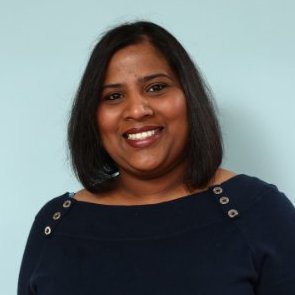 I am now a Licensing Associate now at UNeMed Corporation, the technology transfer office at the University of Nebraska Medical Center. UNeMed gave me the opportunity to attend Association of University Technology Managers’ 2017 Annual Meeting in Hollywood, Fla. I noticed a stark difference in cultures between the two conferences.
I am now a Licensing Associate now at UNeMed Corporation, the technology transfer office at the University of Nebraska Medical Center. UNeMed gave me the opportunity to attend Association of University Technology Managers’ 2017 Annual Meeting in Hollywood, Fla. I noticed a stark difference in cultures between the two conferences.
AUTM 2017 was an open environment that involved sharing each other’s expertise, and a desire to see others succeed. This was evident in the first-time attendee’s reception where I met a dozen people who willingly took the time to get to know me, ask questions about my role at UNeMed and provide tech transfer career development advice. I interacted with industry and seasoned tech transfer professionals, and I enjoyed talking to them. They shared with me their journey, and warned me of pitfalls they experienced.
Overall, the atmosphere was one of interaction, learning and growth.
Of the many sessions I attended, a few stood out:
1. I learned about the innovation life cycle, and how important it is to communicate effectively within and out of the technology transfer office. The panelists did an exceptional job during the session, “Telling and Re-telling your Office’s Story.” They shared how their offices amplified the story of each invention, and how they aligned it with the University’s mission. They shared timelines, expressed the importance of reciprocal relationships with University public relations as well as local news media. They stressed the need to generate technology content on their websites, and allow inventors to tell their stories. The panelists were Quentin Thomas, Marketing Manager at Emory University; Paul Tumarkin, Senior Manager of Marketing and Communications at Tech Launch Arizona; and Sara Dagen, Technical Editor at the University of Florida’s Office of Technology Licensing.
2. The other session I really enjoyed was, “Communication skills for Licensing Professionals,” by Julie Watson, Special Counsel at Marshall Gerstein IP; Lina Axanova, Associate Director at Penn Center for Innovation; Leef Smith Barnes, Chief Marketing and Communications Officer at AUTM; and John Christie, Executive Director of the Office of Technology Transfer and Intellectual Property Development at Tulane University . This was important to me as a beginner in tech transfer because it taught me how to interpret scientific, legal and business languages. They shared nuggets of wisdom pertaining to listening, business email etiquette, negotiation language and conflict resolution. I learned that communication mostly involves active listening, and practicing firm but empathetic conversations.
3. Another panel—Christopher Noble, Technology Licensing Officer at MIT; Kathleen Denis, Associate VP at Rockefeller University; Duke Leahey, Founder of Nidus Investments; and Kelly Sexton, Asst. Vice Chancellor for Technology Commercialization and New Ventures at North Carolina State University—discussed different methods of collaborating with companies for industry sponsored research. They talked about deciding who should be the Chief Executive Officer of a startup: the student or the principle investigator? They shed light on the various intellectual property obstacles that tech transfer offices run into during industry sponsored research as well as when setting up a new company. The panelists spent significant time on de-risking technologies before presenting to industry, which I thought was important and significant as I start my career.
4. UNeMed President and CEO, Michael Dixon, was one of the panelists—along with Alicia Loffler, Associate Provost for Innovation and New Ventures at Northwestern University; Lesley Millar-Nicholson, Director at MIT’s Technology Licensing Office; and Neil Veloso, Executive Director of Technology Transfer at Johns Hopkins University —in the session, “Creating a Sustainable Culture for Entrepreneurship and Innovation.” Each panelist gave a short talk about their various programs to improve faculty engagement and invention reporting. They stressed the importance of developing an innovative and entrepreneurial mindset within local communities that, in turn, would produce angel investors and startups. They shared ideas and programs that provided tech transfer resources to their students, post-docs and faculty.
5. The innovation keynote speaker, Kavita Shukla, mesmerized the audience with her captivating story of innovation and entrepreneurship. She talked about her innovation, FreshPaper, and the arduous task of establishing a startup company, Fenugreen. FreshPaper is bio-degradable paper infused with organic spices and herbs that inhibit bacterial and fungal growth providing an effective solution to food spoilage. Fenugreen is a social enterprise taking on the massive global challenge of food waste with a simple innovation.
She said she avoided a serious case of traveler diarrhea when she visited India at the age of 12, because of a spice-filled drink her grandmother gave her. The drink then led her to develop FreshPaper in her garage. She talked about being a gawky 16-year-old, “walking into the patent office” to file her first patent on FreshPaper. She dreamed of providing food to nations that didn’t have refrigeration. “Doubt kills more dreams than failure will,” she said. And she shared how she pushed through every obstacle thrown at her.
She challenged individuals to dream, to design new products and to talk to everyone possible about their ideas until they can find someone that can help them move forward. She was glad for the existence of tech transfer offices because she believes they have the power to support these dreams and ideas, and make innovation happen.
Her talk encouraged me as a woman, and as a tech transfer professional, to support other women to succeed and become innovators and entrepreneurs.
Concussion detection startup Avert selected for national demo day

Avert CEO Preston Badeer presents his company’s concussion technology during UNeMed’s 2016 Demo Day event in October. (File photo)
WASHINGTON, D.C. (April 6, 2017)—Avert, an Omaha company developing a concussion-detection device, was one of just 40 university startup companies selected for a national demo day later this month.
Based on research by Nick Stergiou, PhD, director of UNO’s Department of Biomechanics, the device uses a person’s balance as a way to measure brain health.
All healthy people make constant, subconscious adjustments to their balance as they stand in place. Dr. Stergiou’s innovative approach was to find a way to recognize the hidden patterns in those adjustments. After a person suffers a brain injury, such as a concussion, it changes the pattern of those subconscious adjustments.
Even when a person exhibits no outward symptoms, Avert’s technology can still detect the injury without relying on subjective questionnaires or clinical judgements.
Using the device would be similar to standing on a bathroom scale for about 30 seconds.
Hosted by the National Council of Entrepreneurial Tech Transfer, the University Startups Conference and Demo Day begins the three-day event on April 18. Organizers plan to bring together more than 300 entrepreneurs, venture capitalists, industry professionals, angel investors, and corporate executives, among others.
Startup will develop blood test for unstable coronary artery disease
OMAHA, Nebraska (March 27, 2017)—A startup accelerator, Academic Technology Ventures, is building a new biomedical startup company with an invention created at the University of Nebraska Medical Center. The startup, HealthCheck, is based on a biomarker discovered at UNMC that could help doctors and cardiologists more accurately diagnose different types of coronary artery disease.
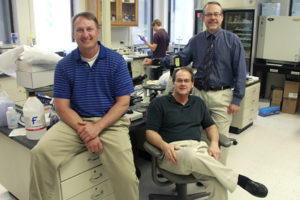
An interdisciplinary team of researchers at the University of Nebraska Medical Center in Omaha—Michael Duryee (left), Geoff Thiele (center) and Dan Anderson (right)—believe they found a way to determine who will develop potentially deadly heart disease with a simple blood test. (UNeMed file photo)
“Currently, there’s no way to differentiate the 47-year-old with stable coronary artery disease from the one who suddenly drops dead in his drive-way,” said Joe Runge, the Director of Business Development at UNeMed, the technology transfer office at UNMC.
HealthCheck’s blood test could give healthcare providers the insight to predict which patients are likely to develop the more dangerous, unstable form of coronary artery disease.
“It solves a huge problem,” said Corey Park, chairman and founder of Academic Technology Ventures. “That would be key for a doctor to be able to say, ‘Hey, change your lifestyle now.'”
Coronary artery disease is the accumulation of plaques inside the arteries. Recent research has shown that virtually everyone, regardless of age, has some form of the disease. Some people have a stable, non-life-threatening form of the disease. Others have the more dangerous, unstable version.
In the unstable, and usually lethal, form of the disease, large deposits of plaque can break open, creating one of two life-threatening problems.
A piece of dislodged plaque might be swept away in the blood stream. The debris could then wedge itself further downstream, acting as a dam that cuts off blood flow to the heart. Or, back at the rupture site, clotting factor and blood platelets rush to the injury. In the process they create a similar bottleneck that reduces or cuts off blood flow.
The result of either scenario is a sudden heart attack or a stroke.
Telling the difference between stable and unstable coronary artery disease has been a stubborn riddle of medicine until a trio of UNMC scientists developed the new blood test. The inventors are Geoff Thiele, PhD, a professor of internal medicine; Michael Duryee, a research coordinator in the College of Medicine; and Dan Anderson, M.D., PhD, a professor and practicing cardiologist at UNMC and Nebraska Medicine.
They found that patients with unstable coronary artery disease also had in their blood large amounts of certain molecule known as MAA, which is short for malondialdehyde–acetaldehyde.
A blood test that looks specifically for the MAA molecule would give healthcare providers a better picture of a patient’s health. Rather than using a simple blood pressure reading or cholesterol count, a high MAA count could help a physician prescribe a more effective course.
“I’ve lost family members to heart disease,” said Jason Pottinger, the director of business strategy at Academic Technology Ventures. “I have family members right now with heart disease. I think they would have benefitted greatly from some real, hard evidence that would be like a slap in the face. A slap in the face to say, ‘Listen, this is science, and this is where you’re heading. Don’t be a statistic.'”
HealthCheck will initially set up in New Jersey, where the company is expected to raise additional capital to support further testing. The additional tests will be used to secure FDA clearance, and hopefully enter the market within the next two or three years, Park said.
“Best-case scenario is this becomes a standardized test with yearly screenings,” Park said. “I think it’s got enough legitimacy to become—not necessarily mandated—but part of that regular regimen.”
UNMC scientists achieve research milestone with Parkinson’s disease
Drug that transforms immune system may predict motor improvement
by Tom O’Connor, UNMC
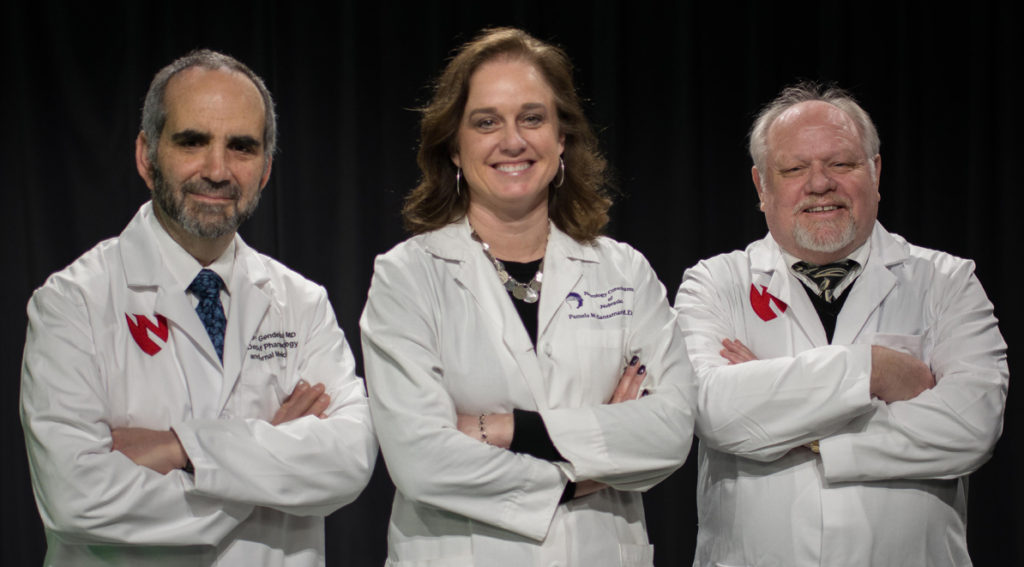
From left are Howard Gendelman, M.D., Pamela Santamaria, M.D., and R. Lee Mosley, PhD (Photo: UNMC)
In an early phase human clinical trial, researchers at the University of Nebraska Medical Center tested a drug that transforms the immune system for diagnostic and therapeutic gain in Parkinson’s disease (PD).
The medicine was proven safe and generally well tolerated. Side effects were minimal, but included skin irritation, bone pain and an allergic reaction. Preliminary evidence of improvement in motor skills was observed and recorded in several of the treated patients, but validation will require larger patient enrollments.
PD ravages nearly one million Americans and generates direct and indirect costs of nearly $25 billion per year in the U.S. alone.
The findings – which appear today in the journal npj Parkinson’s Disease – mark a milestone for PD research. At the heart of the discovery was the immune transformation of disease-inciting circulating white blood cells (called effector T-cells or Teff) to cells that protect and defend against brain injury (called regulatory T cells or Treg). The drug changed neurodestructive Teff into functional neuroprotective Tregs.
The research team was headed by two UNMC scientists, Howard Gendelman, M.D., professor and chair of the Department of Pharmacology and Experimental Neuroscience, and R. Lee Mosley, PhD, professor of Pharmacology and Experimental Neuroscience and head of the Movement Disorders Research Laboratory. The discovery results from more than two decades of laboratory and animal investigation.
The idea was conceived in cell studies then validated in animals. During each step, immune transformation was realized with the drug granulocyte macrophage colony stimulating factor (also known as Sargramostim® Sanofi-Genzyme Pharmaceuticals).
Importantly, such drug-induced transformation has not only been successful for PD but also holds promise for a range of neurodegenerative disorders that include Alzheimer’s disease, stroke and amyotrophic lateral sclerosis.
To conduct the Phase I clinical study, scientists partnered with 14 academic and community-based physicians and neuroscientists with extensive expertise in neurophysiology, bioimaging, clinical trials execution and movement disorders. The research was conducted in basic science laboratories at UNMC and Scripps Research Institute in La Jolla, Calif. The study subjects were seen at UNMC’s clinical partner, Nebraska Medicine.
Clinical support was overseen at UNMC by Pamela Santamaria, M.D., a Nebraska Medicine neurologist and founder of Neurology Consultants of Nebraska; Danish Bhatti, M.D., assistant professor in the Department of Neurological Sciences; and by David Standaert, M.D., PhD, professor and chair of Neurology and director of the Division of Movement Disorders at the University of Alabama at Birmingham.
Using a blinded clinical study approach for investigation, the patients, their caregivers and their physicians could not tell whether the drug or a placebo was being administered.
The drug was found to produce significant and encouraging changes in the production of Treg cells in the blood of patients. These same changes did not take place in patients who received the placebo. Initial clinical observations proved encouraging and varied in intensity between patients, Dr. Gendelman said.
During the trial, physiological brain improvements were seen in specific motor areas of the brain for those patients receiving Sargramostim. This was recorded through the use of magnetoencephalography by a research team headed by Tony Wilson, PhD, associate professor and vice chair, basic/translational research for UNMC and director of the Magnetoencephalography Laboratory in the Department of Neurological Sciences.
Blood metabolites known to increase the number of neuroprotective Treg cells were observed in parallel studies on the same blood samples used to record the immune biomarkers. These biochemical studies were performed at the Scripps Research Institute by Gary Siuzdak, PhD, professor and director, Scripps Center for Metabolomics and Mass Spectrometry.
Doses of L-DOPA and other dopamine-sparing drugs used to treat PD were continued to all study subjects throughout the study.
“To our knowledge, this study represents the first time immune transformation was performed on any patient with neurodegenerative disease,” Dr. Mosley said.
Dr. Gendelman said the next step will be a broader study that will include larger patient numbers. This is being planned in the next one to two years, he said, after the manufacture of an oral medicine.
For more information on the study, call 402-559-6941.
Complete technology portfolio is now available
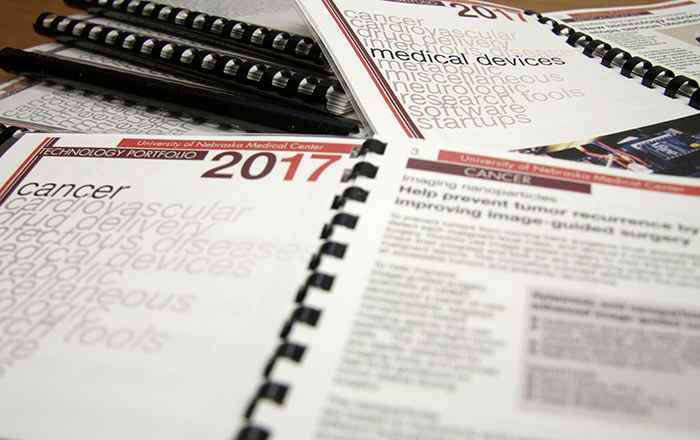
OMAHA, Nebraska (March 23, 2017)—All technologies available for partnering and licensing opportunities through UNeMed are now easier to access.
UNeMed’s complete technology portfolio is available in a single document that can be downloaded, printed or mailed. Digital versions of the portfolio are free and can be viewed and downloaded here or below.
Printed copies of the 84-page booklet are also available, and free copies can be found at UNeMed’s office. Booklets are printed as-needed, so immediate supplies are limited. Printed copies can also be mailed, but will require a $3 fee to offset shipping and handling costs. Mail orders can be placed here.
The UNeMed portfolio describes all the top technologies from UNMC’s and UNO’s talented researchers. Also included are details about UNeMed’s most promising startup companies.
Digital versions of the portfolio will be regularly updated to include the most recent innovation disclosures, and to remove recently licensed technologies that are no longer available.
Any questions about UNeMed’s Technology Portfolio can be directed to Charlie Litton at charles.litton@unmc.edu or 402-559-2468.
UNeMed Technology Portfolio by UNeMed Corporation on Scribd
ProTransit lands $1.7 million DOD grant for treating spinal injuries
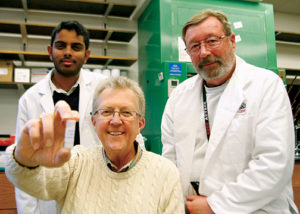
ProTransit Nanotherapy president and CEO Gary Madsen, PhD, (center) shows off a vial of prototypes that could one day be incorporated into skin care products such as sunscreen and cosmetics. The nanoparticles, formulated by scientists Steve Curran and Bala Vamsi Karuturi, PhD,(left) and Steve Curran (right), are vehicles that can deliver powerful antioxidants to the deepest layers of skin where they can help prevent skin cancer, wrinkles and blemishes.
CLEVELAND, Ohio (March 7, 2017)—A $1.7 million grant from the Department of Defense is expected to push Omaha startup ProTransit Nanotherapy closer to FDA approval on a new treatment for acute spinal injuries, according to a press release issued today.
A portion of the award will help ProTransit use UNMC’s Nebraska Nanomedicine Production Plant to optimize the production of a proprietary nanoparticle. The nanoparticle was invented by former UNMC researcher Vinod Labhasetwar, PhD
Now a professor of biomedical engineering at Cleveland Clinic, Dr. Labhasetwar’s innovative nanoparticle has shown dramatic potential when injected immediately after a spinal injury. Called Pro-NP™, the technology has shown the ability to prevent further damage to the spinal cord. It may also encourage the body’s natural repair mechanism to heal the injury, the release said.
Further tests will be a deeper study of the overall treatment effects. If successful, results from those studies will then drive an investigational new drug application with the FDA—a critical first step toward a clinical trial in human patients. Spine surgeon and Canada Research Chair in Spinal Injury, Brian Kwon, M.D., PhD, will lead the additional studies out of the University of British Columbia in Vancouver.
According to the press release, the grant attracted interest from the DOD for its potential to be used in battlefield conditions, either “on site or en route to a trauma center.” The technology also has clear civilian applications as a treatment that paramedics could inject in emergencies.
In addition to the new spinal treatment, ProTransit is also developing a topical skin application that could prevent skin cancer while eliminating or reducing wrinkles and other blemishes.
ProTransit Nanotherapy was co-founded by Dr. Labhasetwar and CEO Gary Madsen, PhD Dr. Madsen is the former Entrepreneur in Residence at UNeMed, the technology transfer office at the University of Nebraska Medical Center.
